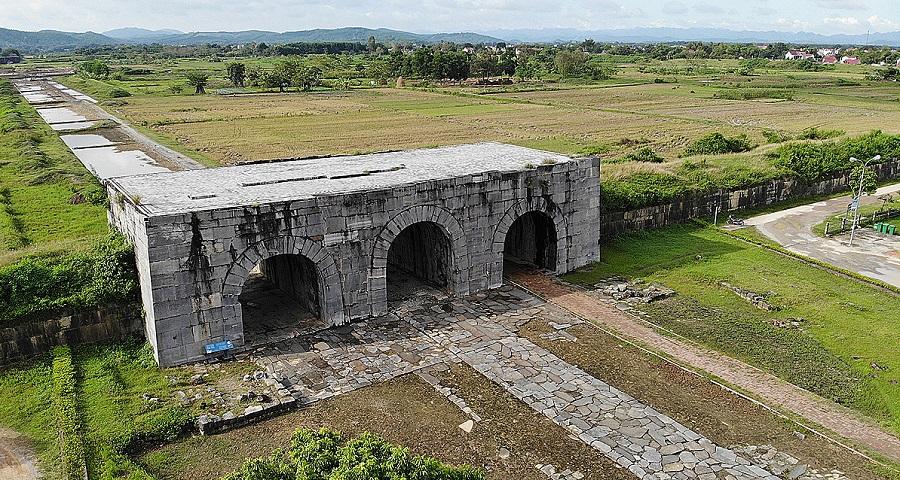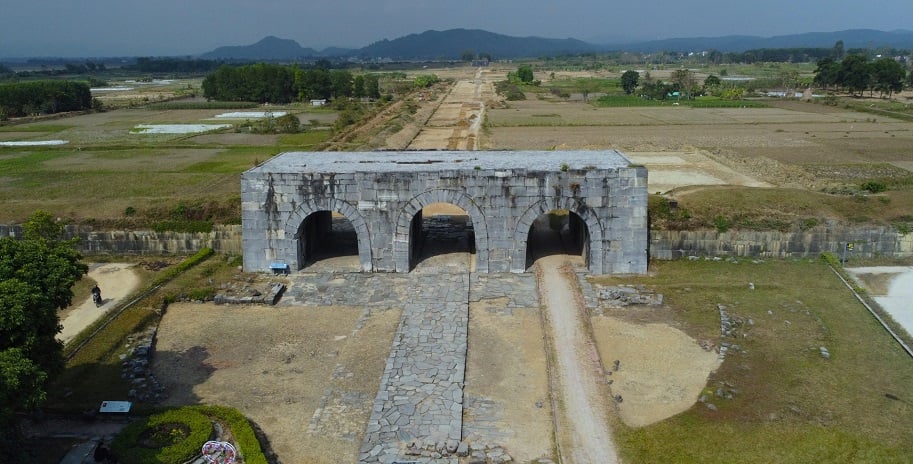
Ho Citadel is a time capsule that stores captivating tales of a very significant era of Vietnamese history. Situated in Thanh Hoa, Ho Dynasty Citadel is widely regarded as a historical and architectural gem, a true testament to the nation’s rich cultural heritage. From its location and architecture to its historical significance and artifacts, Ho Dynasty Citadel invites visitors to travel back in time.
1. Overview of the citadel of the Ho Dynasty
Ho Citadel, a widely known former capital of Vietnam, is one of the country’s most recognizable ancient constructions. Its distinctive architecture and stories beckon many tourists to pay it a visit.
1.1. Location of Ho Citadel
The Citadel of the Ho Dynasty, which is located in Vinh Long, Vinh Loc, Thanh Hoa, boasts a strategic geographical placement. This advantageous position now translates to one of the most gorgeous attractions in the country, achieving the perfect balance between a majestic structure and picturesque surroundings.
Throughout its history, Ho Citadel has gone by many names: An Ton, Tay Do, Tay Kinh, Thach Thanh, Tay Giai, etc. Most of these are bestowed upon the citadel by the locals.
Ho Dynasty Citadel is a UNESCO World Cultural Heritage Site. After 11 long years of application, the citadel of the Ho Dynasty finally earned the coveted accolade, an emblem that recognizes its historical and cultural values.
Moreover, Ho Citadel is surrounded by gorgeous and tranquil scenery. The unspoiled beauty of the landscape is another aspect that attracts numerous tourists to the citadel.

1.2. Entrance fees of Ho Citadel
Despite being a sought-after attraction now, the entrance fees are incredibly affordable compared to other popular tourist sites throughout the country.
- Adults: 40,000 VND
- Children (from 8 to 15 years old): 20,000 VND
- Children under 8: Free of charge
1.3. History of Ho Dynasty Citadel
The Citadel of the Ho Dynasty was built in 1397 under the supervision of Ho Quy Ly, the very first monarch of the dynasty. The reason behind its construction was a coup. When Ho Quy Ly forcibly took the throne in 1400, he relocated the capital and opened up a new chapter in Vietnam’s feudal era.
As the capital of the country from 1398 to 1407, it acted as the political, economic, and cultural center of North Central Vietnam.
During this time, Ho Dynasty Citadel was a historical witness of a critical period in Vietnamese history.

2. The unique architecture of Ho Dynasty
One of Ho Citadel’s names was Thach Thanh, which translates to “Stone Citadel”. The Citadel of the Ho Dynasty was the only imperial building made of stone slabs instead of bricks, unlike many other constructions before it. The large stone slabs required a new construction technique without the use of any mortar.
As expected from a royal building, it had an advantageous position for its time, surrounded by steep mountains and rivers. Back then, it was an ideal position for defense and maritime trade. In the modern era, however, this location paints a gorgeous and majestic painting that is hard to find anywhere else.
2.1. La Thanh Outer Wall
The outer wall, known as La Thanh, envelops the citadel as a protective barrier and the first line of defense. Spanning approximately 4 kilometers, this perimeter reflects the dedication to protecting the inner sanctum from attacks and floods.
2.2. Hao Thanh
Hao Thanh is essentially a moat encircling Ho Citadel’s outer wall. This 90-meter wide and 6.5-meter deep component was a tremendous idea in the meticulous plan behind the citadel’s defense. Undoubtedly, the moat played a crucial role in ensuring the citadel’s safety.
2.3. Hoang Thanh (Inner Citadel)
Within the heart of the citadel lies Hoang Thanh, an architectural masterpiece that once housed the royal family. Its meticulous design, including four gates facing all four directions and the use of massive limestone blocks, speaks volumes about the skills and dedication of the builders.
2.4. Nam Giao Altar
Nam Giao Altar, situated in the south of the citadel’s premises, holds immense cultural and spiritual significance. This symbolic piece of the citadel is not simply an intricate design choice but also an example of the cultural values of the Ho Dynasty.

The four components listed above are what you can still admire with your own eyes. According to ancient records, the citadel was made up of other magnificent pieces. Unfortunately, in the span of 6 long centuries, most of them did not manage to withstand the test of time. Archeologists have uncovered many ruins buried under the ground that signifies the existence of these constructions in the original citadel.
3. A glance at the large collection of artifacts unearthed in Ho Citadel
Ho Dynasty Citadel not only captivates with its architecture but also a treasure trove of artifacts kept in mint condition. These ancient artifacts offer a window into the life and culture that once thrived within these ancient walls. Stone artifacts make up the majority of exhibits inside the citadel, but you can also admire some copper or clay relics. Ho Dynasty Citadel also has a significant connection with the Tran Dynasty, so you can expect quite a few items from that era as well.
Here are some incredible artifacts that you will get to see with your own eyes at the citadel:
- Stone slabs used to build the citadel
- Cannons and catapults
- A coin vase from the Tran Dynasty
- Clay roof tiles
- Sculptures
- Everyday items
- A stone dragon head

Thanh Hoa is an underrated tourist destination due to the sheer volume of attractions located in the areas surrounding it. However, visiting the province will help you uncover quite a few prominent sites like Sam Son Beach, Hai Tien Beach, Ham Rong Bridge, Ben En National Park, etc.
After exploring the Citadel of the Ho Dynasty and its fellow Thanh Hoa attractions, continue your journey to other cities and provinces like Phu Quoc, Nha Trang, Hoi An, Da Nang, and Ha Long. The more destinations you stop by, the more exciting your Vietnam travel experience will be.
A vacation will not be complete without comfortable accommodation. To add a sense of luxury to your stay, consider choosing Vinpearl’s hotels and resorts, where services and amenities will cater to all your needs. At Vinpearl, you can indulge in pleasant hospitality across the country. In addition, with Vinpearl, you can add a hint of excitement to your stay with a day at the entertainment complexes of VinWonders.



>>> Book rooms in Vinpearl Phu Quoc, Vinpearl Nha Trang, Vinpearl Hoi An, Vinpearl Resort & Spa Ha Long for the best accommodation in Vietnam!
Ho Citadel stands as a living embodiment of a significant era in Vietnam’s illustrious history. Thanks to the daring architectural design and compelling stories attached to it, the citadel solidifies itself as one of the most worthwhile attractions to visit in the country. As you wander through its grand halls and artifacts, you may find a new appreciation for the ingenuity and creativity of Vietnamese people.
>>> Book voucher, combo, tour to Phu Quoc, Nha Trang, Hoi An and embark on a journey to Vietnam!
